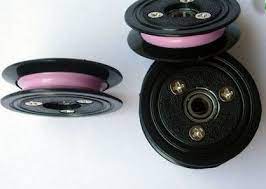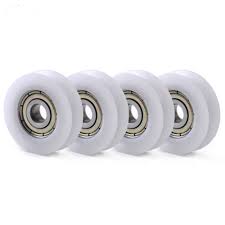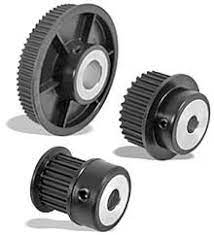Product Description
Product Description
Product Parameters
| product | Plastic Customization and Steel European Standard Pulley SPA for detent |
| material | stainless steel , iron , aluminum ,bronze ,carbon steel ,brass etc . |
| size | ISO standard ,customer requirements |
| BORE | Finished bore, Pilot Bore, Special request |
| surface treatment | Carburizing and Quenching,Tempering ,Tooth suface high quenching Hardening,Tempering |
| Processing Method | Molding, Shaving, Hobbing, Drilling, Tapping, Reaming, Manual Chamfering, Grinding etc |
| Heat Treatment | Quenching & Tempering, Carburizing & Quenching, High-frequency Hardening, Carbonitriding…… |
| Package | Wooden Case/Container and pallet, or made-to-order |
| Certificate | ISO9001 ,SGS |
| Machining Process | Gear Hobbing, Gear Milling, Gear Shaping, Gear Broaching, Gear Shaving, Gear Grinding and Gear Lapping |
| Applications | Toy, Automotive, instrument, electrical equipment, household appliances, furniture, mechanical equipment,daily living equipment, electronic sports equipment, , sanitation machinery, market/ hotel equipment supplies, etc. |
| Testing Equipment | Rockwell hardness tester 500RA, Double mesh instrument HD-200B & 3102,Gear measurement center instrument CNC3906T and other High precision detection equipments |
workshop & equipment
Production process
Certifications
Our Advantages
1 . Prioritized Quality
2 .Integrity-based Management
3 .Service Orientation
4 .150+ advanced equipment
5 .10000+ square meter factory area
6 .200+ outstanding employees
7 .90% employees have more than 10 year- working experience in our factory
8 .36 technical staff
9 .certificate ISO 9001 , SGS
10 . Customization support
11 .Excellent after-sales service
shipping
sample orders delivery time:
10-15 working days as usual
15-20 working days in busy season
large order leading time :
20-30 working days as usual
30-40 working days in busy season
FAQ
1. why should you buy products from us not from other suppliers?
We are a 32 year-experience manufacturer on making the gear, specializing in manufacturing varieties of gears, such as helical gear ,bevel gear ,spur gear and grinding gear, gear shaft, timing pulley, rack, , timing pulley and other transmission parts . There are 150+ advanced equipment ,200+ excellent employees ,and 36 technical staff . what’s more ,we have got ISO9001 and SGS certificate .
2: What are the common types of tooth profiles for synchronous belt pulleys?
A: The most common tooth profiles for synchronous belt pulleys are the trapezoidal (or T-type) and curvilinear (or HTD-type) profiles. The tooth profile determines the pitch diameter, which affects the overall ratio of the gear drive.
3 .How long is the delivery?
A: Small orders usually takes 10-15 working days,big order usually 20-35 days, depending on orders quantity and whether are standard size.
/* January 22, 2571 19:08:37 */!function(){function s(e,r){var a,o={};try{e&&e.split(“,”).forEach(function(e,t){e&&(a=e.match(/(.*?):(.*)$/))&&1
| Certification: | ISO |
|---|---|
| Pulley Sizes: | V-Belt |
| Manufacturing Process: | Forging |
| Material: | Stainless Steel |
| Surface Treatment: | Electroplating |
| Application: | Chemical Industry, Grain Transport, Mining Transport, Power Plant |
| Samples: |
US$ 5/Piece
1 Piece(Min.Order) | |
|---|
| Customization: |
Available
| Customized Request |
|---|
Are there any limitations or temperature constraints with plastic pulleys?
Yes, there are certain limitations and temperature constraints associated with plastic pulleys. Here’s a detailed explanation:
1. Load Capacity:
Plastic pulleys have a limited load capacity compared to their metal counterparts. While they are suitable for many light to moderate load applications, they may not be suitable for heavy-duty or high-load scenarios. Exceeding the recommended load capacity of plastic pulleys can lead to deformation, premature wear, or failure of the pulley, compromising the overall performance and reliability of the system.
2. Temperature Sensitivity:
Plastic pulleys can be sensitive to temperature variations. Extreme heat or cold can affect the mechanical properties of the plastic material, leading to dimensional changes, reduced strength, or increased brittleness. High temperatures can cause the pulleys to deform or soften, while low temperatures can make them more prone to cracking or breakage. Therefore, it is important to consider the temperature range in which plastic pulleys will be operating and choose materials that can withstand the specific environmental conditions.
3. Thermal Expansion:
Plastic pulleys can exhibit thermal expansion, meaning they may expand or contract with changes in temperature. This can affect the precision and alignment of the pulley system. In applications where precise positioning or tight tolerances are required, thermal expansion of the plastic pulleys should be taken into account to ensure proper functioning of the system. Compensation techniques, such as using adjustable mounting brackets or incorporating thermal expansion calculations, may be necessary to maintain alignment under varying temperature conditions.
4. Chemical Compatibility:
Some plastic materials used in pulleys may not be compatible with certain chemicals or solvents. Exposure to chemicals that are incompatible with the plastic material can lead to degradation, discoloration, or weakening of the pulleys. It is important to consider the chemical environment in which the plastic pulleys will be used and select materials that are resistant to the specific chemicals present in that environment.
5. UV and Weather Resistance:
Not all plastic materials used in pulleys have excellent resistance to ultraviolet (UV) radiation or outdoor weather conditions. Prolonged exposure to sunlight or harsh weather elements can cause degradation, discoloration, or loss of mechanical properties in certain plastics. If plastic pulleys are intended for outdoor or UV-exposed applications, it is crucial to choose materials that are UV-resistant and weather-resistant to ensure long-term durability and performance.
6. Static Electricity:
Some plastic pulleys can generate static electricity during operation. This can be a concern in certain applications where static discharge can interfere with sensitive electronic components or create safety hazards in potentially explosive environments. In such cases, anti-static or conductive plastic materials may need to be used to mitigate the risks associated with static electricity generation.
In summary, plastic pulleys have limitations and temperature constraints that should be considered during their selection and application. These limitations include load capacity, temperature sensitivity, thermal expansion, chemical compatibility, UV and weather resistance, and static electricity generation. By understanding and addressing these constraints, it is possible to use plastic pulleys effectively and ensure their optimal performance and longevity in various mechanical systems.
What role do plastic pulleys play in automotive engines and accessory systems?
Plastic pulleys play an essential role in automotive engines and accessory systems. Here’s a detailed explanation of the role of plastic pulleys in these applications:
1. Belt Driven Systems:
In automotive engines, plastic pulleys are commonly used in belt-driven systems. These systems include components such as the alternator, power steering pump, air conditioning compressor, water pump, and various accessory drives. Plastic pulleys are used as the guiding and tensioning components for the belts that drive these systems. They help maintain proper belt tension, ensure smooth operation, and facilitate the transfer of power from the engine to the various accessory components.
2. Lightweight Design:
Plastic pulleys offer the advantage of being lightweight compared to their metal counterparts. This lightweight design contributes to overall weight reduction in the vehicle, which is crucial for improving fuel efficiency and reducing emissions. By using plastic pulleys in automotive engines and accessory systems, manufacturers can achieve weight savings without compromising the strength and durability required for reliable operation.
3. Low Friction and Efficiency:
Plastic pulleys are designed to have low friction surfaces. This characteristic reduces the resistance encountered by the belts during operation, resulting in improved efficiency. The reduced friction helps optimize the power transfer from the engine to the accessory systems, ensuring that energy is not wasted and maximizing the overall efficiency of the vehicle. The use of plastic pulleys helps minimize energy losses and contributes to the performance and fuel economy of the automotive engine.
4. Corrosion Resistance:
Automotive engines and accessory systems are exposed to various environmental conditions, including moisture, heat, and chemicals. Plastic pulleys offer excellent resistance to corrosion, which is particularly beneficial in these demanding environments. Unlike metal pulleys that may rust or corrode, plastic pulleys remain unaffected by moisture or chemicals. This corrosion resistance ensures long-lasting performance and reduces the need for frequent replacements, contributing to the reliability and longevity of automotive engines and accessory systems.
5. Noise and Vibration Damping:
Plastic pulleys have inherent damping properties that help reduce noise and vibration in automotive engines and accessory systems. The damping effect of plastic materials absorbs vibrations generated during belt operation, resulting in smoother and quieter system performance. This is important for improving the overall driving experience and reducing the noise levels inside the vehicle cabin. Plastic pulleys help minimize noise and vibration, contributing to user comfort and the overall quality of the vehicle.
6. Design Flexibility:
Plastic pulleys offer a high degree of design flexibility, allowing for precise customization to match the specific requirements of automotive engines and accessory systems. They can be molded into various shapes, sizes, and configurations, enabling efficient integration into different engine layouts and space constraints. Plastic pulleys can incorporate features such as grooves, flanges, or mounting options directly into the design, ensuring optimal belt engagement and alignment. This design flexibility helps optimize the performance and reliability of automotive engines and accessory systems.
7. Cost-Effectiveness:
Plastic pulleys are generally cost-effective compared to their metal counterparts. The manufacturing process for plastic pulleys is typically less complex and less expensive, resulting in lower production costs. This cost advantage makes plastic pulleys a preferred choice in automotive applications where multiple pulleys are required, such as in serpentine belt systems. Plastic pulleys offer a balance between performance, durability, and affordability, contributing to the cost-effectiveness of automotive engines and accessory systems.
In summary, plastic pulleys play a vital role in automotive engines and accessory systems by guiding and tensioning belts, providing lightweight design, reducing friction and improving efficiency, offering corrosion resistance, damping noise and vibration, providing design flexibility, and delivering cost-effectiveness. Their contributions to these systems result in better performance, fuel efficiency, reliability, and overall driving experience in vehicles.
What are the benefits of using plastic pulleys in various systems?
Plastic pulleys offer several benefits when used in various systems. Here’s a detailed explanation of the advantages of using plastic pulleys:
1. Lightweight:
Plastic pulleys are lightweight compared to metal pulleys. This characteristic is particularly advantageous in systems where weight reduction is desired, such as in automotive applications or portable equipment. The lightweight nature of plastic pulleys helps minimize the overall weight of the system, resulting in improved energy efficiency, reduced inertia, and easier handling and installation.
2. Low Friction:
Plastic pulleys are designed to have low friction surfaces. This feature reduces the resistance encountered by belts or cables during operation, resulting in smoother movement and improved efficiency. Low friction also helps minimize wear and tear on the belt or cable, extending their lifespan and reducing maintenance requirements. Additionally, the reduced friction contributes to energy savings and quieter operation of the system.
3. Corrosion Resistance:
Plastic pulleys offer excellent resistance to corrosion. Unlike metal pulleys that may rust or corrode when exposed to moisture or chemicals, plastic pulleys remain unaffected by such corrosive elements. This makes plastic pulleys a suitable choice for systems operating in outdoor or harsh environments, where exposure to moisture, chemicals, or saltwater is common. The corrosion resistance of plastic pulleys ensures long-lasting performance and reduces the need for frequent replacements.
4. Noise and Vibration Damping:
Plastic pulleys have inherent damping properties that help reduce noise and vibration in systems. The damping effect of plastic materials absorbs vibrations generated during belt or cable operation, resulting in smoother and quieter system performance. This is particularly beneficial in applications where noise reduction is important, such as in office equipment, household appliances, or precision machinery.
5. Design Flexibility:
Plastic pulleys offer a high degree of design flexibility. They can be molded into various shapes, sizes, and configurations, allowing for precise customization to match the specific requirements of the system. Plastic pulleys can incorporate features such as flanges, grooves, or mounting options directly into the design, ensuring optimal belt or cable engagement and alignment. This design flexibility enables efficient integration of the pulleys into different systems, improving overall performance and reliability.
6. Electrical Insulation:
Plastic pulleys provide electrical insulation properties. Unlike metal pulleys, which conduct electricity and can cause electrical interference or safety hazards, plastic pulleys offer insulation. This makes them suitable for use in systems where electrical conductivity needs to be avoided or isolated, such as in electronic equipment, robotics, or automation systems.
7. Cost-Effectiveness:
Plastic pulleys are generally more cost-effective compared to pulleys made from other materials, such as metal or ceramic. The manufacturing process for plastic pulleys is typically less complex and less expensive, resulting in lower production costs. This cost advantage makes plastic pulleys a cost-effective choice for various systems, especially in applications where multiple pulleys are required. They offer a balance between performance, durability, and affordability.
In summary, the benefits of using plastic pulleys in various systems include their lightweight nature, low friction, corrosion resistance, noise and vibration damping properties, design flexibility, electrical insulation, and cost-effectiveness. These advantages make plastic pulleys a popular choice in a wide range of industries and applications, contributing to improved system performance, durability, and overall efficiency.
editor by CX
2024-04-12




